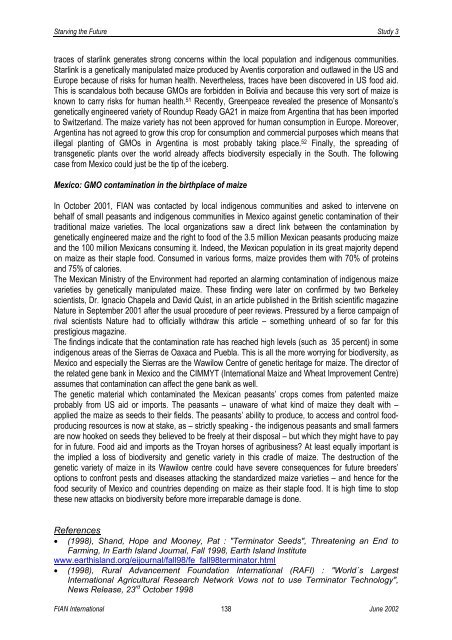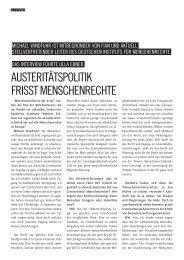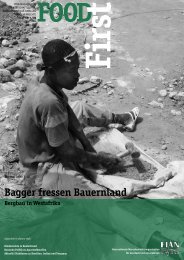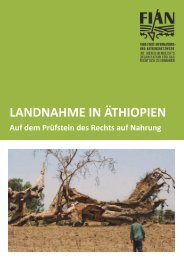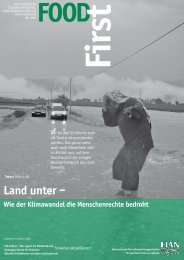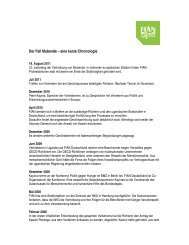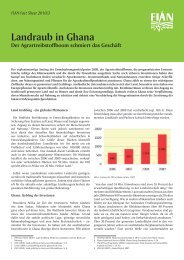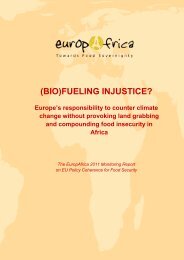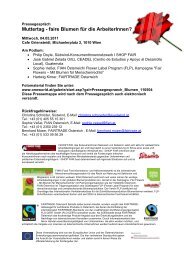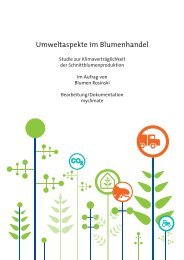Study 3: Ecodestruction and the Right to Food: The Cases of Water ...
Study 3: Ecodestruction and the Right to Food: The Cases of Water ...
Study 3: Ecodestruction and the Right to Food: The Cases of Water ...
Create successful ePaper yourself
Turn your PDF publications into a flip-book with our unique Google optimized e-Paper software.
Starving <strong>the</strong> Future <strong>Study</strong> 3<br />
traces <strong>of</strong> starlink generates strong concerns within <strong>the</strong> local population <strong>and</strong> indigenous communities.<br />
Starlink is a genetically manipulated maize produced by Aventis corporation <strong>and</strong> outlawed in <strong>the</strong> US <strong>and</strong><br />
Europe because <strong>of</strong> risks for human health. Never<strong>the</strong>less, traces have been discovered in US food aid.<br />
This is sc<strong>and</strong>alous both because GMOs are forbidden in Bolivia <strong>and</strong> because this very sort <strong>of</strong> maize is<br />
known <strong>to</strong> carry risks for human health. 51 Recently, Greenpeace revealed <strong>the</strong> presence <strong>of</strong> Monsan<strong>to</strong>’s<br />
genetically engineered variety <strong>of</strong> Roundup Ready GA21 in maize from Argentina that has been imported<br />
<strong>to</strong> Switzerl<strong>and</strong>. <strong>The</strong> maize variety has not been approved for human consumption in Europe. Moreover,<br />
Argentina has not agreed <strong>to</strong> grow this crop for consumption <strong>and</strong> commercial purposes which means that<br />
illegal planting <strong>of</strong> GMOs in Argentina is most probably taking place. 52 Finally, <strong>the</strong> spreading <strong>of</strong><br />
transgenetic plants over <strong>the</strong> world already affects biodiversity especially in <strong>the</strong> South. <strong>The</strong> following<br />
case from Mexico could just be <strong>the</strong> tip <strong>of</strong> <strong>the</strong> iceberg.<br />
Mexico: GMO contamination in <strong>the</strong> birthplace <strong>of</strong> maize<br />
In Oc<strong>to</strong>ber 2001, FIAN was contacted by local indigenous communities <strong>and</strong> asked <strong>to</strong> intervene on<br />
behalf <strong>of</strong> small peasants <strong>and</strong> indigenous communities in Mexico against genetic contamination <strong>of</strong> <strong>the</strong>ir<br />
traditional maize varieties. <strong>The</strong> local organizations saw a direct link between <strong>the</strong> contamination by<br />
genetically engineered maize <strong>and</strong> <strong>the</strong> right <strong>to</strong> food <strong>of</strong> <strong>the</strong> 3.5 million Mexican peasants producing maize<br />
<strong>and</strong> <strong>the</strong> 100 million Mexicans consuming it. Indeed, <strong>the</strong> Mexican population in its great majority depend<br />
on maize as <strong>the</strong>ir staple food. Consumed in various forms, maize provides <strong>the</strong>m with 70% <strong>of</strong> proteins<br />
<strong>and</strong> 75% <strong>of</strong> calories.<br />
<strong>The</strong> Mexican Ministry <strong>of</strong> <strong>the</strong> Environment had reported an alarming contamination <strong>of</strong> indigenous maize<br />
varieties by genetically manipulated maize. <strong>The</strong>se finding were later on confirmed by two Berkeley<br />
scientists, Dr. Ignacio Chapela <strong>and</strong> David Quist, in an article published in <strong>the</strong> British scientific magazine<br />
Nature in September 2001 after <strong>the</strong> usual procedure <strong>of</strong> peer reviews. Pressured by a fierce campaign <strong>of</strong><br />
rival scientists Nature had <strong>to</strong> <strong>of</strong>ficially withdraw this article – something unheard <strong>of</strong> so far for this<br />
prestigious magazine.<br />
<strong>The</strong> findings indicate that <strong>the</strong> contamination rate has reached high levels (such as 35 percent) in some<br />
indigenous areas <strong>of</strong> <strong>the</strong> Sierras de Oaxaca <strong>and</strong> Puebla. This is all <strong>the</strong> more worrying for biodiversity, as<br />
Mexico <strong>and</strong> especially <strong>the</strong> Sierras are <strong>the</strong> Wawilow Centre <strong>of</strong> genetic heritage for maize. <strong>The</strong> direc<strong>to</strong>r <strong>of</strong><br />
<strong>the</strong> related gene bank in Mexico <strong>and</strong> <strong>the</strong> CIMMYT (International Maize <strong>and</strong> Wheat Improvement Centre)<br />
assumes that contamination can affect <strong>the</strong> gene bank as well.<br />
<strong>The</strong> genetic material which contaminated <strong>the</strong> Mexican peasants’ crops comes from patented maize<br />
probably from US aid or imports. <strong>The</strong> peasants – unaware <strong>of</strong> what kind <strong>of</strong> maize <strong>the</strong>y dealt with –<br />
applied <strong>the</strong> maize as seeds <strong>to</strong> <strong>the</strong>ir fields. <strong>The</strong> peasants’ ability <strong>to</strong> produce, <strong>to</strong> access <strong>and</strong> control foodproducing<br />
resources is now at stake, as – strictly speaking - <strong>the</strong> indigenous peasants <strong>and</strong> small farmers<br />
are now hooked on seeds <strong>the</strong>y believed <strong>to</strong> be freely at <strong>the</strong>ir disposal – but which <strong>the</strong>y might have <strong>to</strong> pay<br />
for in future. <strong>Food</strong> aid <strong>and</strong> imports as <strong>the</strong> Troyan horses <strong>of</strong> agribusiness? At least equally important is<br />
<strong>the</strong> implied a loss <strong>of</strong> biodiversity <strong>and</strong> genetic variety in this cradle <strong>of</strong> maize. <strong>The</strong> destruction <strong>of</strong> <strong>the</strong><br />
genetic variety <strong>of</strong> maize in its Wawilow centre could have severe consequences for future breeders’<br />
options <strong>to</strong> confront pests <strong>and</strong> diseases attacking <strong>the</strong> st<strong>and</strong>ardized maize varieties – <strong>and</strong> hence for <strong>the</strong><br />
food security <strong>of</strong> Mexico <strong>and</strong> countries depending on maize as <strong>the</strong>ir staple food. It is high time <strong>to</strong> s<strong>to</strong>p<br />
<strong>the</strong>se new attacks on biodiversity before more irreparable damage is done.<br />
References<br />
• (1998), Sh<strong>and</strong>, Hope <strong>and</strong> Mooney, Pat : "Termina<strong>to</strong>r Seeds", Threatening an End <strong>to</strong><br />
Farming, In Earth Isl<strong>and</strong> Journal, Fall 1998, Earth Isl<strong>and</strong> Institute<br />
www.earthisl<strong>and</strong>.org/eijournal/fall98/fe_fall98termina<strong>to</strong>r.html<br />
• (1998), Rural Advancement Foundation International (RAFI) : "World´s Largest<br />
International Agricultural Research Network Vows not <strong>to</strong> use Termina<strong>to</strong>r Technology",<br />
News Release, 23 rd Oc<strong>to</strong>ber 1998<br />
FIAN International 138<br />
June 2002


